Importance of In-depth Knowledge for Early Child Educators
VerifiedAdded on 2020/04/21
|13
|3122
|90
Report
AI Summary
This report delves into the critical importance of in-depth knowledge for early childhood educators, emphasizing the need to understand various developmental domains, including cognitive, physical, and socio-emotional aspects. The analysis draws upon observations of children aged 0-3 years, highlighting the interrelationships between these domains, particularly with language development, and distinguishing between typical and atypical development. The report underscores the child's role as an active learner, emphasizing the value of self-directed learning and the need for educators to foster an environment that encourages exploration and discovery. The report also advocates for a holistic view of child development, recognizing the unique developmental pathways of each child and the significance of early childhood education. The conclusion reinforces the necessity of educators possessing a comprehensive understanding of child development to effectively support children's growth and learning. The report also references a video that provides examples of the concepts discussed.
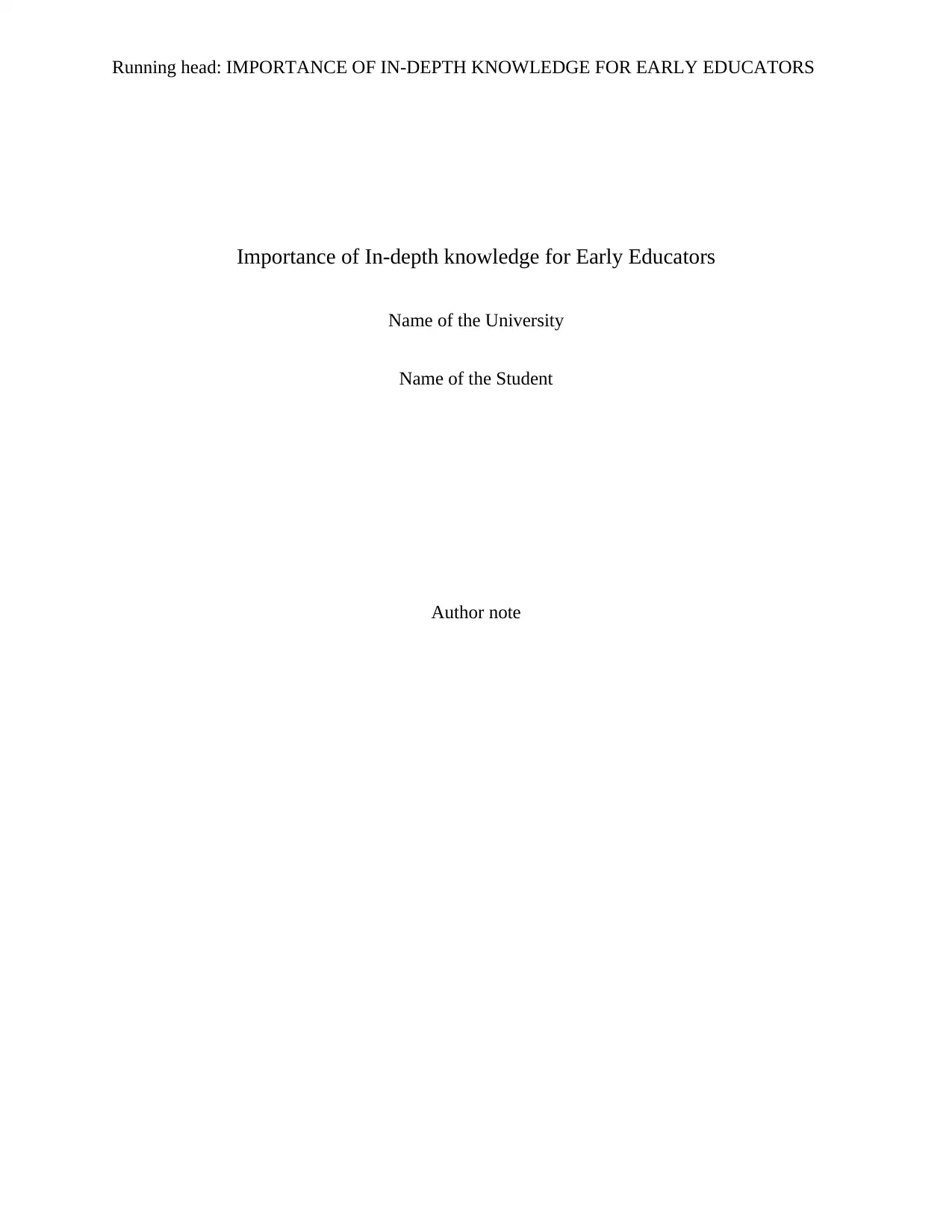
Running head: IMPORTANCE OF IN-DEPTH KNOWLEDGE FOR EARLY EDUCATORS
Importance of In-depth knowledge for Early Educators
Name of the University
Name of the Student
Author note
Importance of In-depth knowledge for Early Educators
Name of the University
Name of the Student
Author note
Paraphrase This Document
Need a fresh take? Get an instant paraphrase of this document with our AI Paraphraser
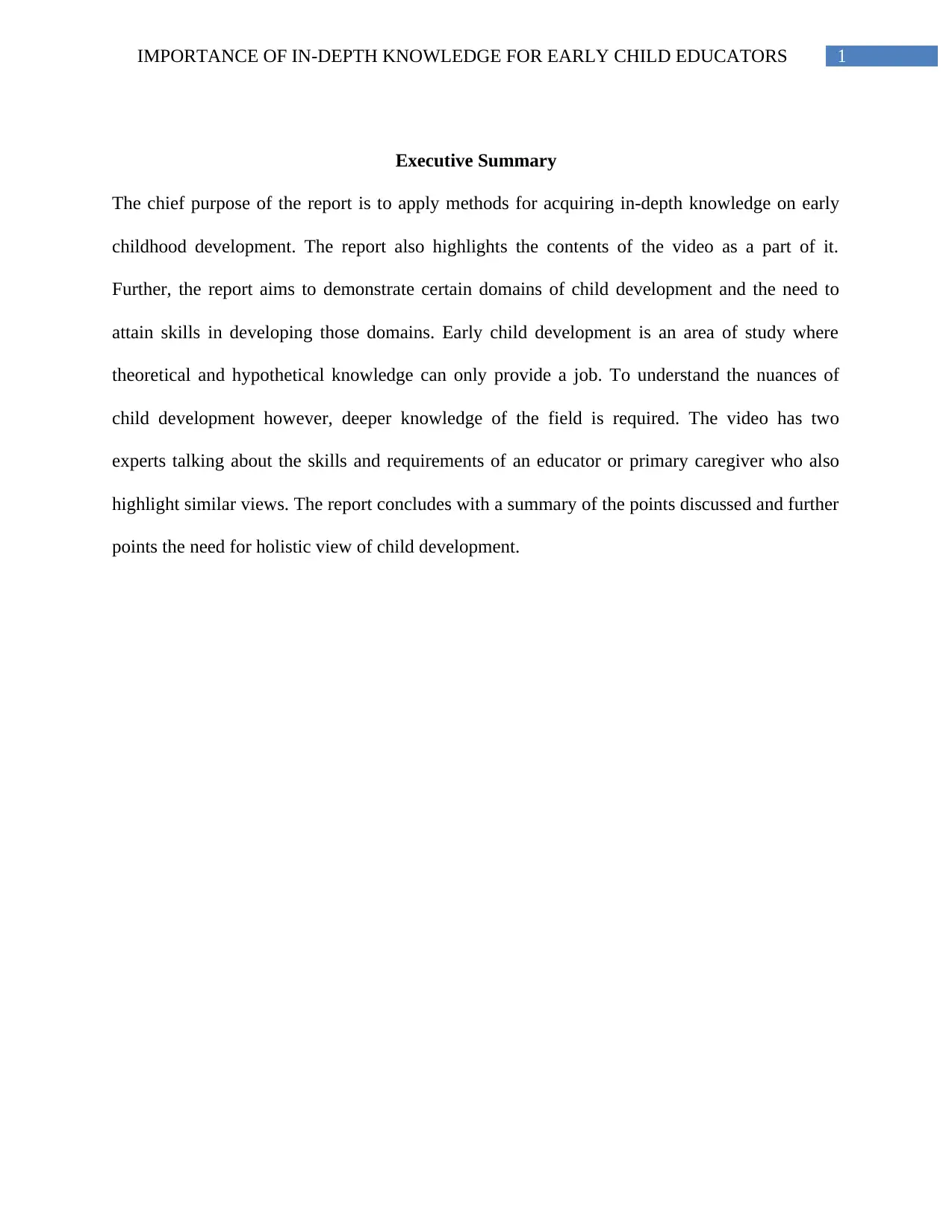
1IMPORTANCE OF IN-DEPTH KNOWLEDGE FOR EARLY CHILD EDUCATORS
Executive Summary
The chief purpose of the report is to apply methods for acquiring in-depth knowledge on early
childhood development. The report also highlights the contents of the video as a part of it.
Further, the report aims to demonstrate certain domains of child development and the need to
attain skills in developing those domains. Early child development is an area of study where
theoretical and hypothetical knowledge can only provide a job. To understand the nuances of
child development however, deeper knowledge of the field is required. The video has two
experts talking about the skills and requirements of an educator or primary caregiver who also
highlight similar views. The report concludes with a summary of the points discussed and further
points the need for holistic view of child development.
Executive Summary
The chief purpose of the report is to apply methods for acquiring in-depth knowledge on early
childhood development. The report also highlights the contents of the video as a part of it.
Further, the report aims to demonstrate certain domains of child development and the need to
attain skills in developing those domains. Early child development is an area of study where
theoretical and hypothetical knowledge can only provide a job. To understand the nuances of
child development however, deeper knowledge of the field is required. The video has two
experts talking about the skills and requirements of an educator or primary caregiver who also
highlight similar views. The report concludes with a summary of the points discussed and further
points the need for holistic view of child development.
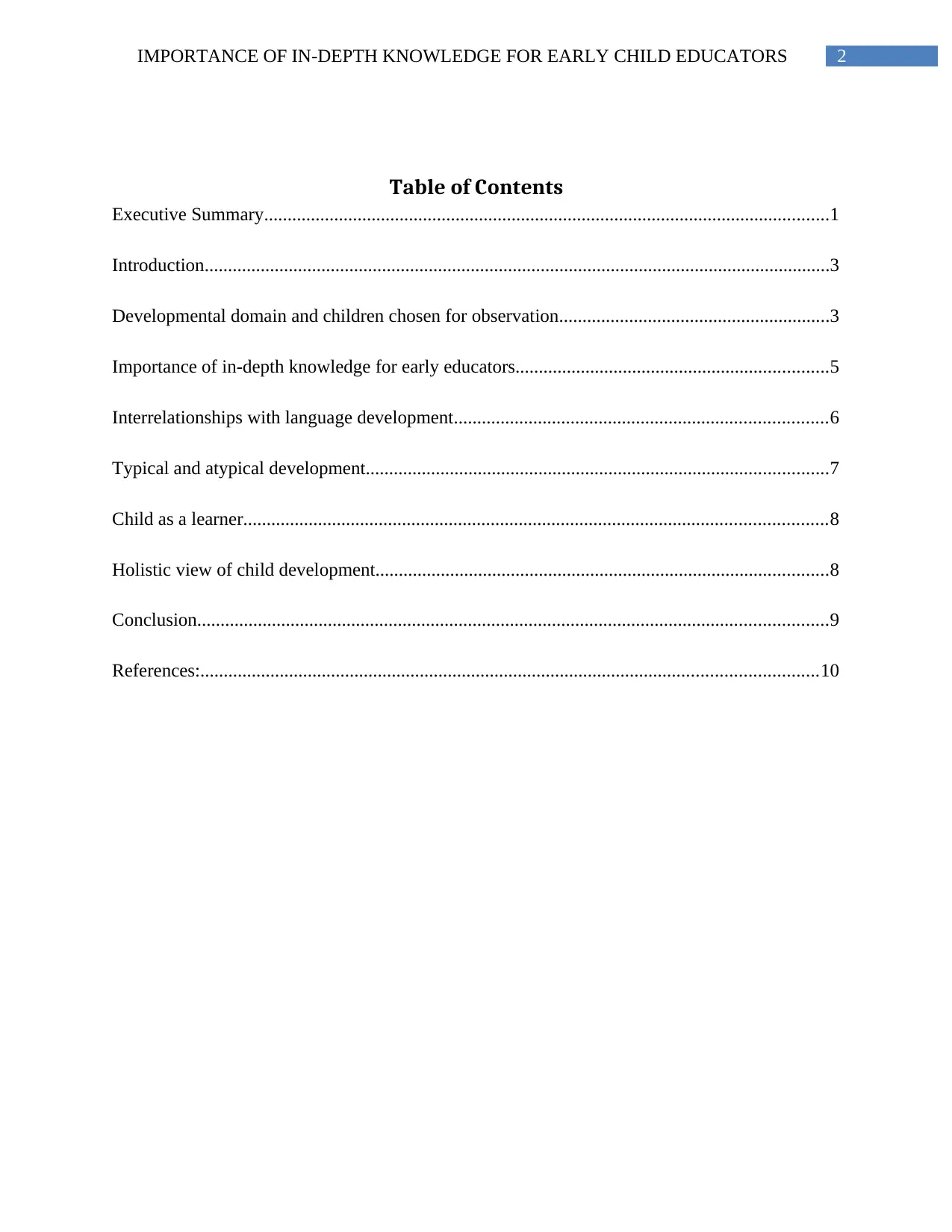
2IMPORTANCE OF IN-DEPTH KNOWLEDGE FOR EARLY CHILD EDUCATORS
Table of Contents
Executive Summary.........................................................................................................................1
Introduction......................................................................................................................................3
Developmental domain and children chosen for observation..........................................................3
Importance of in-depth knowledge for early educators...................................................................5
Interrelationships with language development................................................................................6
Typical and atypical development...................................................................................................7
Child as a learner.............................................................................................................................8
Holistic view of child development.................................................................................................8
Conclusion.......................................................................................................................................9
References:....................................................................................................................................10
Table of Contents
Executive Summary.........................................................................................................................1
Introduction......................................................................................................................................3
Developmental domain and children chosen for observation..........................................................3
Importance of in-depth knowledge for early educators...................................................................5
Interrelationships with language development................................................................................6
Typical and atypical development...................................................................................................7
Child as a learner.............................................................................................................................8
Holistic view of child development.................................................................................................8
Conclusion.......................................................................................................................................9
References:....................................................................................................................................10
⊘ This is a preview!⊘
Do you want full access?
Subscribe today to unlock all pages.

Trusted by 1+ million students worldwide
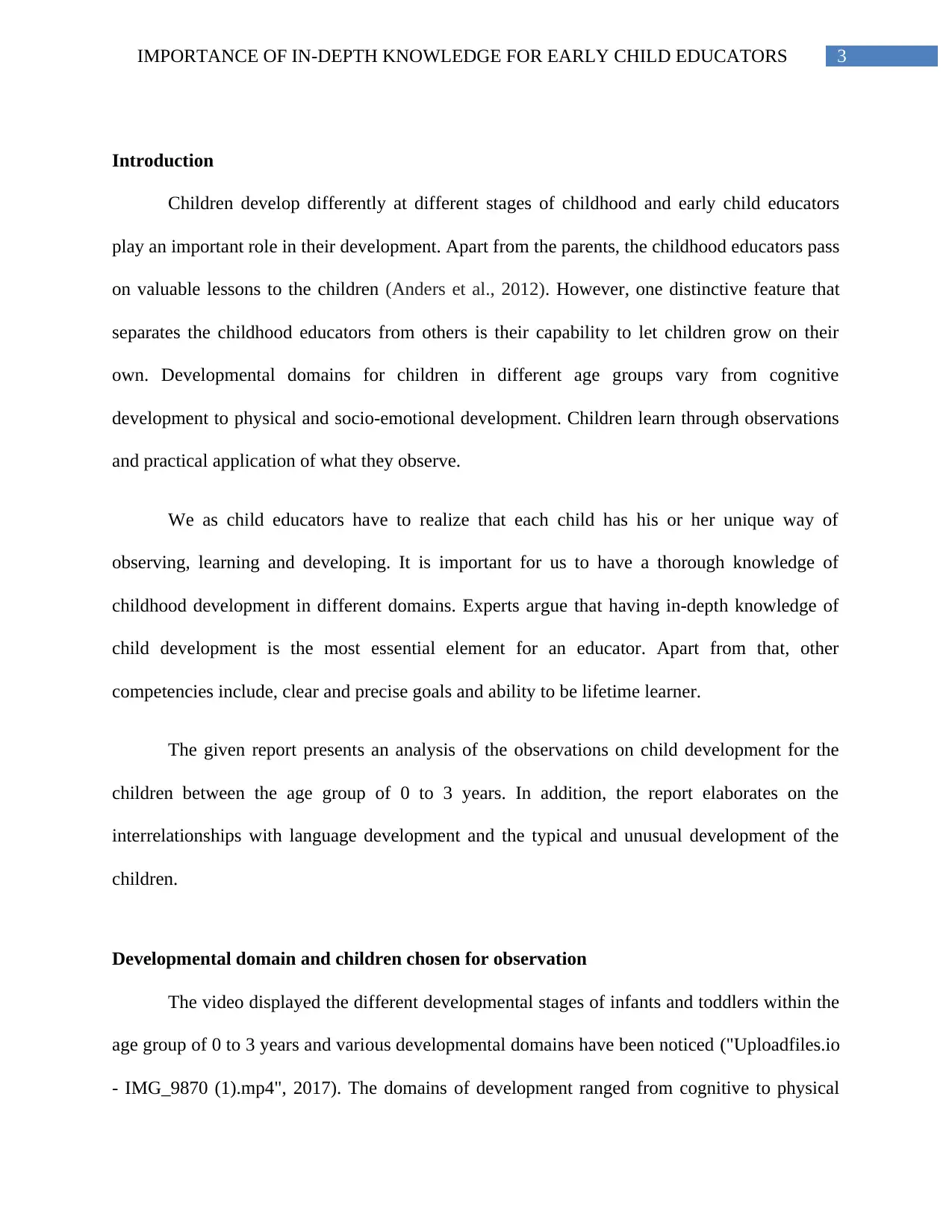
3IMPORTANCE OF IN-DEPTH KNOWLEDGE FOR EARLY CHILD EDUCATORS
Introduction
Children develop differently at different stages of childhood and early child educators
play an important role in their development. Apart from the parents, the childhood educators pass
on valuable lessons to the children (Anders et al., 2012). However, one distinctive feature that
separates the childhood educators from others is their capability to let children grow on their
own. Developmental domains for children in different age groups vary from cognitive
development to physical and socio-emotional development. Children learn through observations
and practical application of what they observe.
We as child educators have to realize that each child has his or her unique way of
observing, learning and developing. It is important for us to have a thorough knowledge of
childhood development in different domains. Experts argue that having in-depth knowledge of
child development is the most essential element for an educator. Apart from that, other
competencies include, clear and precise goals and ability to be lifetime learner.
The given report presents an analysis of the observations on child development for the
children between the age group of 0 to 3 years. In addition, the report elaborates on the
interrelationships with language development and the typical and unusual development of the
children.
Developmental domain and children chosen for observation
The video displayed the different developmental stages of infants and toddlers within the
age group of 0 to 3 years and various developmental domains have been noticed ("Uploadfiles.io
- IMG_9870 (1).mp4", 2017). The domains of development ranged from cognitive to physical
Introduction
Children develop differently at different stages of childhood and early child educators
play an important role in their development. Apart from the parents, the childhood educators pass
on valuable lessons to the children (Anders et al., 2012). However, one distinctive feature that
separates the childhood educators from others is their capability to let children grow on their
own. Developmental domains for children in different age groups vary from cognitive
development to physical and socio-emotional development. Children learn through observations
and practical application of what they observe.
We as child educators have to realize that each child has his or her unique way of
observing, learning and developing. It is important for us to have a thorough knowledge of
childhood development in different domains. Experts argue that having in-depth knowledge of
child development is the most essential element for an educator. Apart from that, other
competencies include, clear and precise goals and ability to be lifetime learner.
The given report presents an analysis of the observations on child development for the
children between the age group of 0 to 3 years. In addition, the report elaborates on the
interrelationships with language development and the typical and unusual development of the
children.
Developmental domain and children chosen for observation
The video displayed the different developmental stages of infants and toddlers within the
age group of 0 to 3 years and various developmental domains have been noticed ("Uploadfiles.io
- IMG_9870 (1).mp4", 2017). The domains of development ranged from cognitive to physical
Paraphrase This Document
Need a fresh take? Get an instant paraphrase of this document with our AI Paraphraser
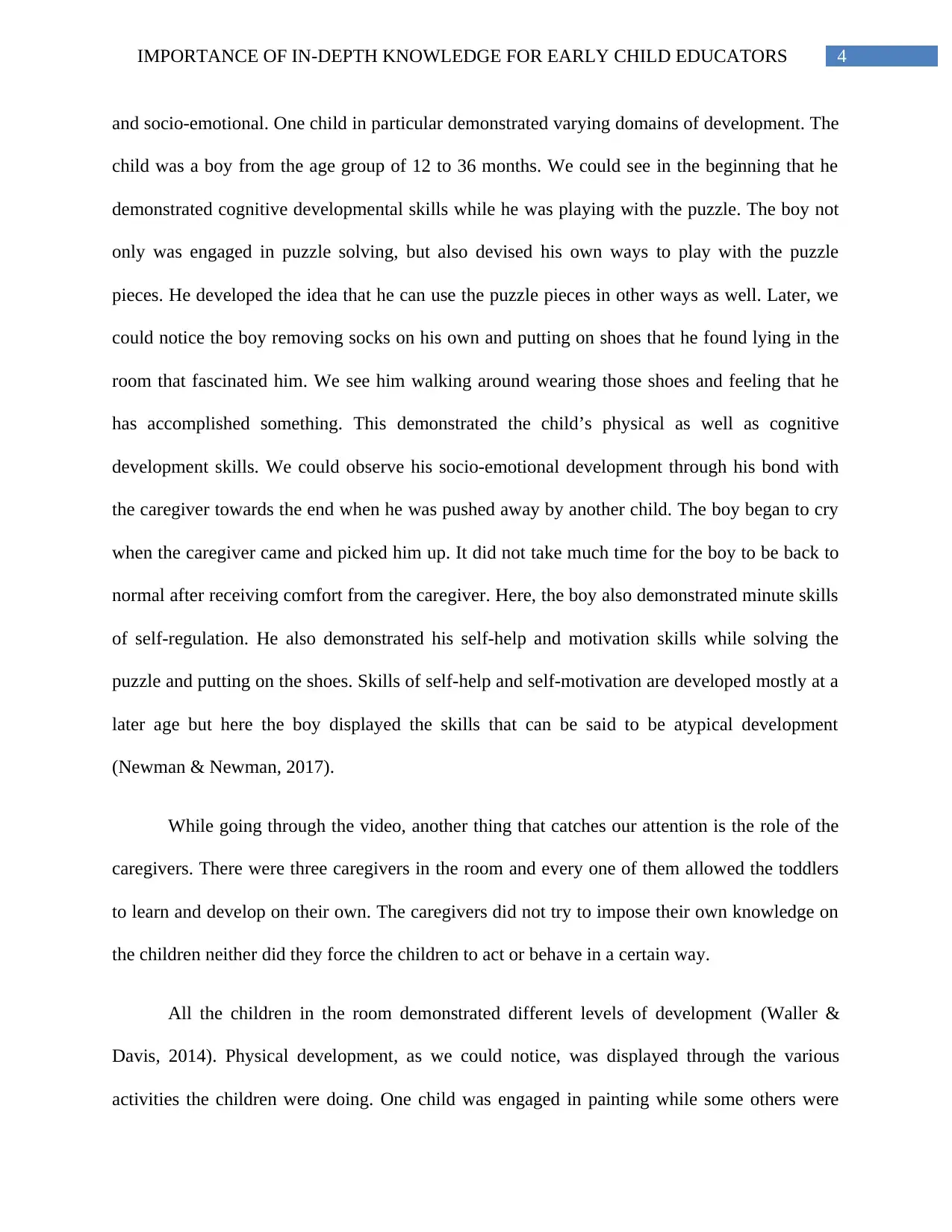
4IMPORTANCE OF IN-DEPTH KNOWLEDGE FOR EARLY CHILD EDUCATORS
and socio-emotional. One child in particular demonstrated varying domains of development. The
child was a boy from the age group of 12 to 36 months. We could see in the beginning that he
demonstrated cognitive developmental skills while he was playing with the puzzle. The boy not
only was engaged in puzzle solving, but also devised his own ways to play with the puzzle
pieces. He developed the idea that he can use the puzzle pieces in other ways as well. Later, we
could notice the boy removing socks on his own and putting on shoes that he found lying in the
room that fascinated him. We see him walking around wearing those shoes and feeling that he
has accomplished something. This demonstrated the child’s physical as well as cognitive
development skills. We could observe his socio-emotional development through his bond with
the caregiver towards the end when he was pushed away by another child. The boy began to cry
when the caregiver came and picked him up. It did not take much time for the boy to be back to
normal after receiving comfort from the caregiver. Here, the boy also demonstrated minute skills
of self-regulation. He also demonstrated his self-help and motivation skills while solving the
puzzle and putting on the shoes. Skills of self-help and self-motivation are developed mostly at a
later age but here the boy displayed the skills that can be said to be atypical development
(Newman & Newman, 2017).
While going through the video, another thing that catches our attention is the role of the
caregivers. There were three caregivers in the room and every one of them allowed the toddlers
to learn and develop on their own. The caregivers did not try to impose their own knowledge on
the children neither did they force the children to act or behave in a certain way.
All the children in the room demonstrated different levels of development (Waller &
Davis, 2014). Physical development, as we could notice, was displayed through the various
activities the children were doing. One child was engaged in painting while some others were
and socio-emotional. One child in particular demonstrated varying domains of development. The
child was a boy from the age group of 12 to 36 months. We could see in the beginning that he
demonstrated cognitive developmental skills while he was playing with the puzzle. The boy not
only was engaged in puzzle solving, but also devised his own ways to play with the puzzle
pieces. He developed the idea that he can use the puzzle pieces in other ways as well. Later, we
could notice the boy removing socks on his own and putting on shoes that he found lying in the
room that fascinated him. We see him walking around wearing those shoes and feeling that he
has accomplished something. This demonstrated the child’s physical as well as cognitive
development skills. We could observe his socio-emotional development through his bond with
the caregiver towards the end when he was pushed away by another child. The boy began to cry
when the caregiver came and picked him up. It did not take much time for the boy to be back to
normal after receiving comfort from the caregiver. Here, the boy also demonstrated minute skills
of self-regulation. He also demonstrated his self-help and motivation skills while solving the
puzzle and putting on the shoes. Skills of self-help and self-motivation are developed mostly at a
later age but here the boy displayed the skills that can be said to be atypical development
(Newman & Newman, 2017).
While going through the video, another thing that catches our attention is the role of the
caregivers. There were three caregivers in the room and every one of them allowed the toddlers
to learn and develop on their own. The caregivers did not try to impose their own knowledge on
the children neither did they force the children to act or behave in a certain way.
All the children in the room demonstrated different levels of development (Waller &
Davis, 2014). Physical development, as we could notice, was displayed through the various
activities the children were doing. One child was engaged in painting while some others were
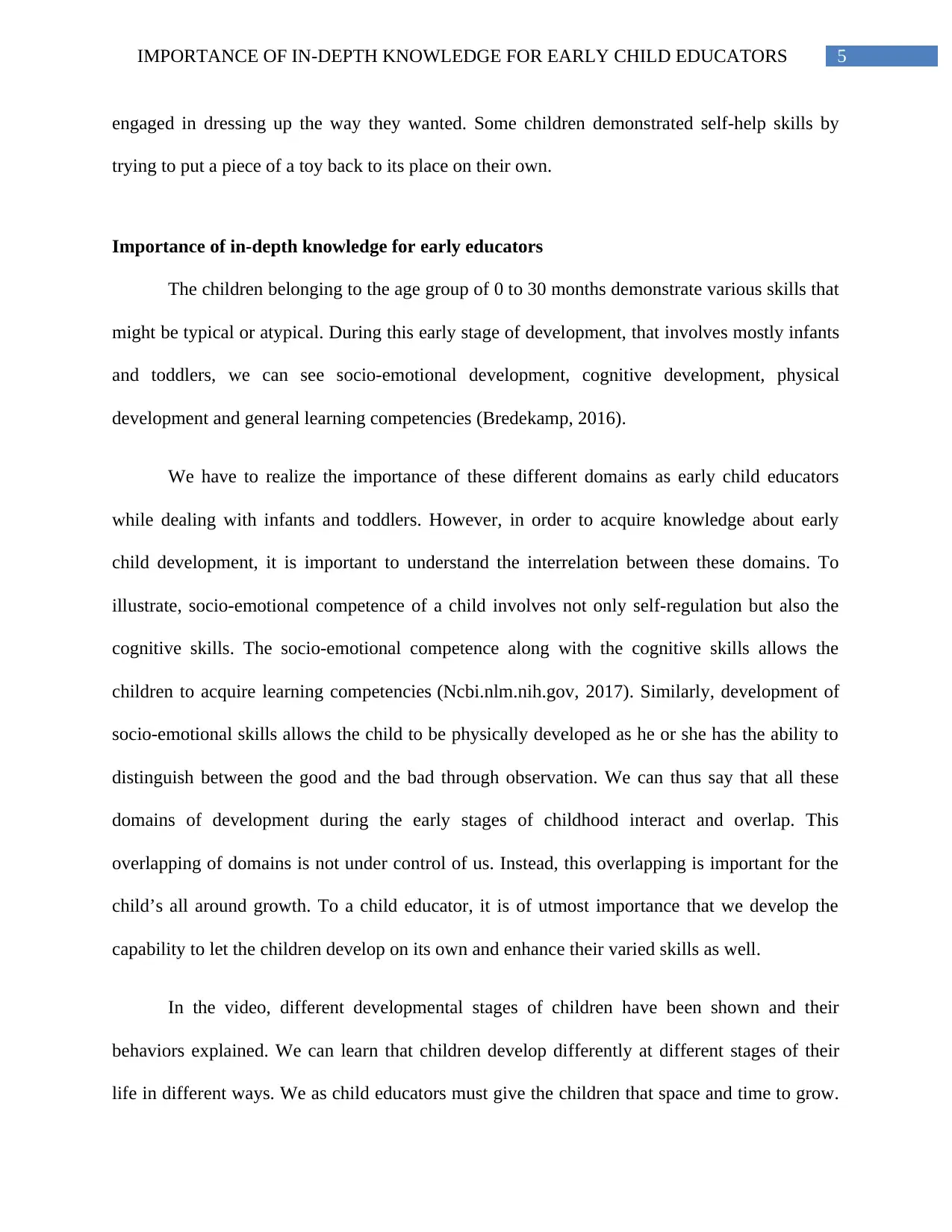
5IMPORTANCE OF IN-DEPTH KNOWLEDGE FOR EARLY CHILD EDUCATORS
engaged in dressing up the way they wanted. Some children demonstrated self-help skills by
trying to put a piece of a toy back to its place on their own.
Importance of in-depth knowledge for early educators
The children belonging to the age group of 0 to 30 months demonstrate various skills that
might be typical or atypical. During this early stage of development, that involves mostly infants
and toddlers, we can see socio-emotional development, cognitive development, physical
development and general learning competencies (Bredekamp, 2016).
We have to realize the importance of these different domains as early child educators
while dealing with infants and toddlers. However, in order to acquire knowledge about early
child development, it is important to understand the interrelation between these domains. To
illustrate, socio-emotional competence of a child involves not only self-regulation but also the
cognitive skills. The socio-emotional competence along with the cognitive skills allows the
children to acquire learning competencies (Ncbi.nlm.nih.gov, 2017). Similarly, development of
socio-emotional skills allows the child to be physically developed as he or she has the ability to
distinguish between the good and the bad through observation. We can thus say that all these
domains of development during the early stages of childhood interact and overlap. This
overlapping of domains is not under control of us. Instead, this overlapping is important for the
child’s all around growth. To a child educator, it is of utmost importance that we develop the
capability to let the children develop on its own and enhance their varied skills as well.
In the video, different developmental stages of children have been shown and their
behaviors explained. We can learn that children develop differently at different stages of their
life in different ways. We as child educators must give the children that space and time to grow.
engaged in dressing up the way they wanted. Some children demonstrated self-help skills by
trying to put a piece of a toy back to its place on their own.
Importance of in-depth knowledge for early educators
The children belonging to the age group of 0 to 30 months demonstrate various skills that
might be typical or atypical. During this early stage of development, that involves mostly infants
and toddlers, we can see socio-emotional development, cognitive development, physical
development and general learning competencies (Bredekamp, 2016).
We have to realize the importance of these different domains as early child educators
while dealing with infants and toddlers. However, in order to acquire knowledge about early
child development, it is important to understand the interrelation between these domains. To
illustrate, socio-emotional competence of a child involves not only self-regulation but also the
cognitive skills. The socio-emotional competence along with the cognitive skills allows the
children to acquire learning competencies (Ncbi.nlm.nih.gov, 2017). Similarly, development of
socio-emotional skills allows the child to be physically developed as he or she has the ability to
distinguish between the good and the bad through observation. We can thus say that all these
domains of development during the early stages of childhood interact and overlap. This
overlapping of domains is not under control of us. Instead, this overlapping is important for the
child’s all around growth. To a child educator, it is of utmost importance that we develop the
capability to let the children develop on its own and enhance their varied skills as well.
In the video, different developmental stages of children have been shown and their
behaviors explained. We can learn that children develop differently at different stages of their
life in different ways. We as child educators must give the children that space and time to grow.
⊘ This is a preview!⊘
Do you want full access?
Subscribe today to unlock all pages.

Trusted by 1+ million students worldwide
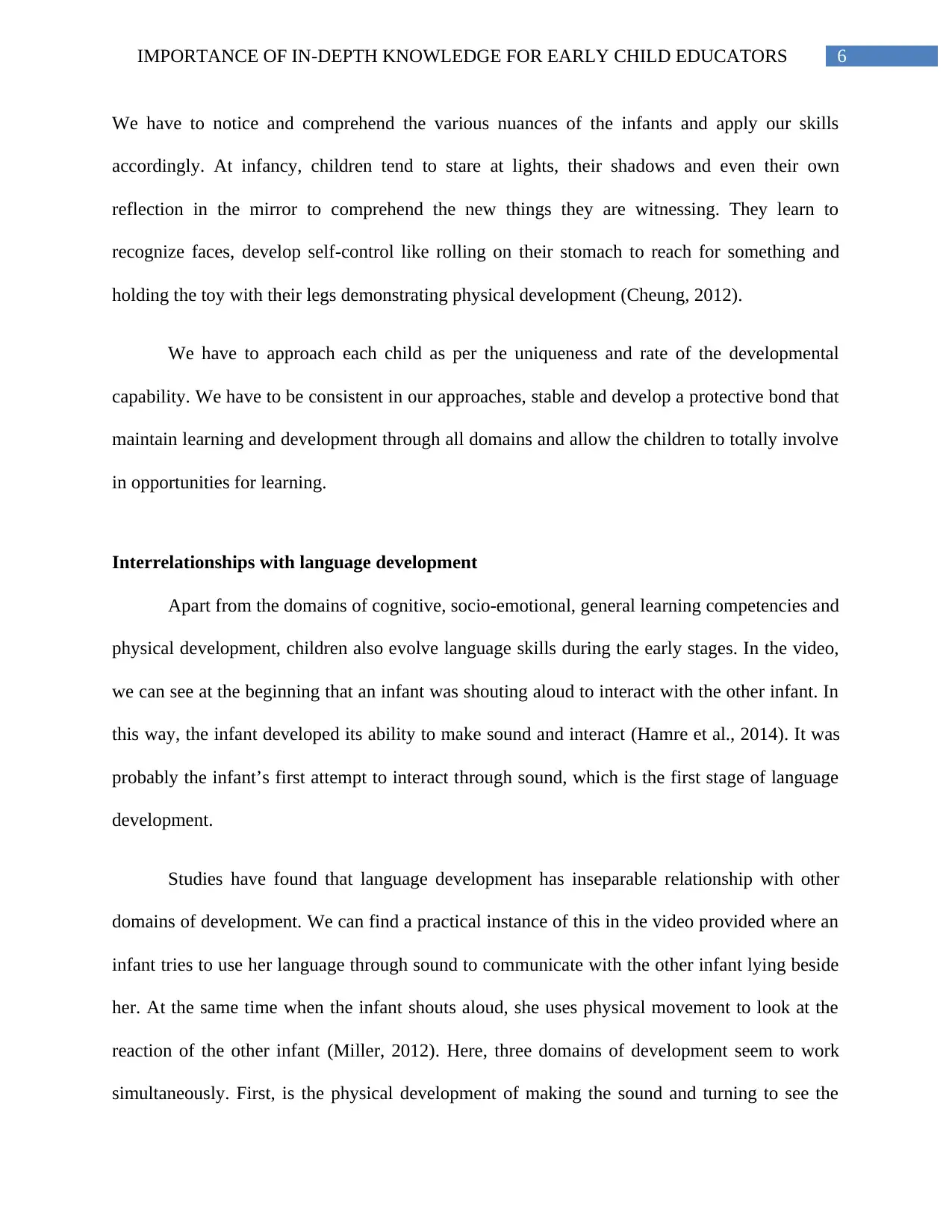
6IMPORTANCE OF IN-DEPTH KNOWLEDGE FOR EARLY CHILD EDUCATORS
We have to notice and comprehend the various nuances of the infants and apply our skills
accordingly. At infancy, children tend to stare at lights, their shadows and even their own
reflection in the mirror to comprehend the new things they are witnessing. They learn to
recognize faces, develop self-control like rolling on their stomach to reach for something and
holding the toy with their legs demonstrating physical development (Cheung, 2012).
We have to approach each child as per the uniqueness and rate of the developmental
capability. We have to be consistent in our approaches, stable and develop a protective bond that
maintain learning and development through all domains and allow the children to totally involve
in opportunities for learning.
Interrelationships with language development
Apart from the domains of cognitive, socio-emotional, general learning competencies and
physical development, children also evolve language skills during the early stages. In the video,
we can see at the beginning that an infant was shouting aloud to interact with the other infant. In
this way, the infant developed its ability to make sound and interact (Hamre et al., 2014). It was
probably the infant’s first attempt to interact through sound, which is the first stage of language
development.
Studies have found that language development has inseparable relationship with other
domains of development. We can find a practical instance of this in the video provided where an
infant tries to use her language through sound to communicate with the other infant lying beside
her. At the same time when the infant shouts aloud, she uses physical movement to look at the
reaction of the other infant (Miller, 2012). Here, three domains of development seem to work
simultaneously. First, is the physical development of making the sound and turning to see the
We have to notice and comprehend the various nuances of the infants and apply our skills
accordingly. At infancy, children tend to stare at lights, their shadows and even their own
reflection in the mirror to comprehend the new things they are witnessing. They learn to
recognize faces, develop self-control like rolling on their stomach to reach for something and
holding the toy with their legs demonstrating physical development (Cheung, 2012).
We have to approach each child as per the uniqueness and rate of the developmental
capability. We have to be consistent in our approaches, stable and develop a protective bond that
maintain learning and development through all domains and allow the children to totally involve
in opportunities for learning.
Interrelationships with language development
Apart from the domains of cognitive, socio-emotional, general learning competencies and
physical development, children also evolve language skills during the early stages. In the video,
we can see at the beginning that an infant was shouting aloud to interact with the other infant. In
this way, the infant developed its ability to make sound and interact (Hamre et al., 2014). It was
probably the infant’s first attempt to interact through sound, which is the first stage of language
development.
Studies have found that language development has inseparable relationship with other
domains of development. We can find a practical instance of this in the video provided where an
infant tries to use her language through sound to communicate with the other infant lying beside
her. At the same time when the infant shouts aloud, she uses physical movement to look at the
reaction of the other infant (Miller, 2012). Here, three domains of development seem to work
simultaneously. First, is the physical development of making the sound and turning to see the
Paraphrase This Document
Need a fresh take? Get an instant paraphrase of this document with our AI Paraphraser
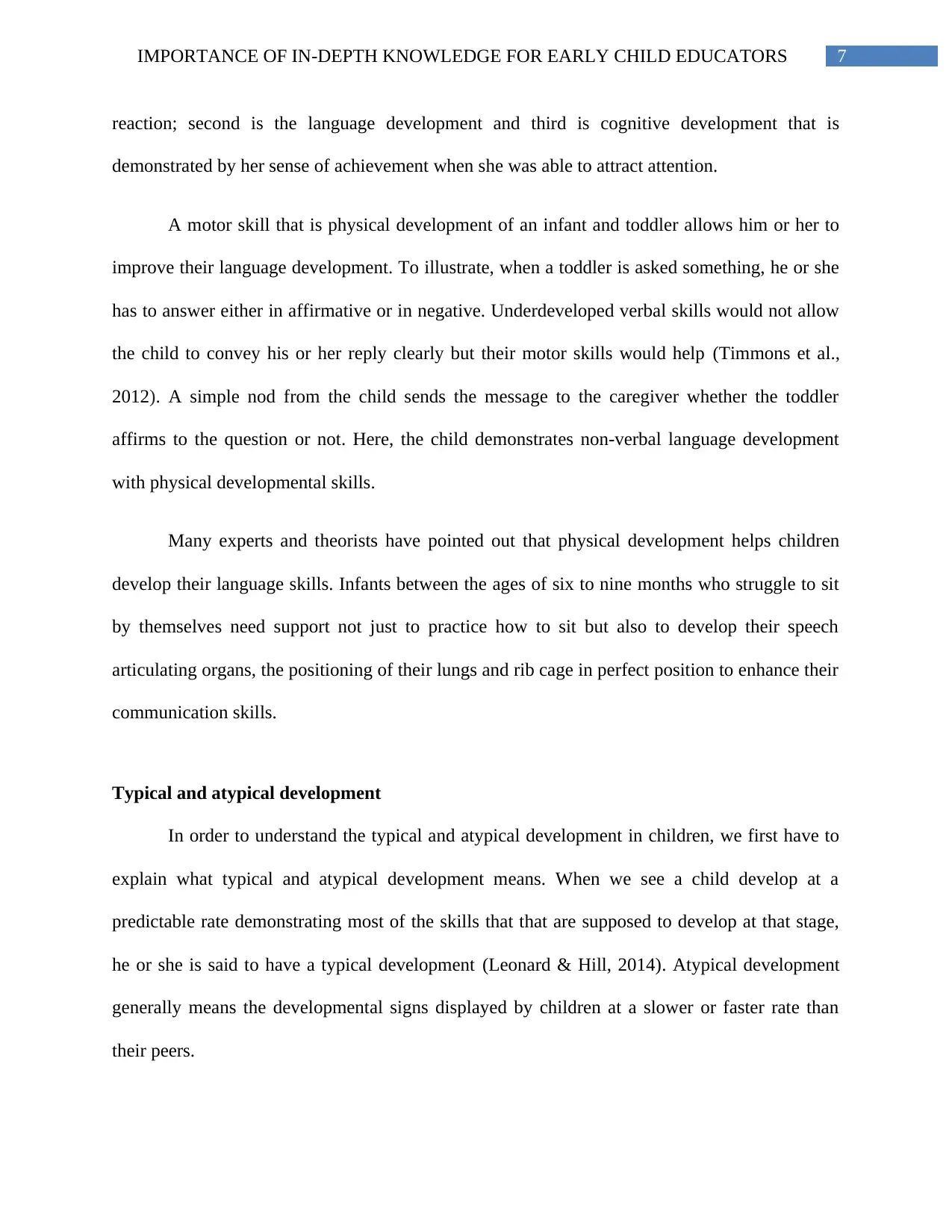
7IMPORTANCE OF IN-DEPTH KNOWLEDGE FOR EARLY CHILD EDUCATORS
reaction; second is the language development and third is cognitive development that is
demonstrated by her sense of achievement when she was able to attract attention.
A motor skill that is physical development of an infant and toddler allows him or her to
improve their language development. To illustrate, when a toddler is asked something, he or she
has to answer either in affirmative or in negative. Underdeveloped verbal skills would not allow
the child to convey his or her reply clearly but their motor skills would help (Timmons et al.,
2012). A simple nod from the child sends the message to the caregiver whether the toddler
affirms to the question or not. Here, the child demonstrates non-verbal language development
with physical developmental skills.
Many experts and theorists have pointed out that physical development helps children
develop their language skills. Infants between the ages of six to nine months who struggle to sit
by themselves need support not just to practice how to sit but also to develop their speech
articulating organs, the positioning of their lungs and rib cage in perfect position to enhance their
communication skills.
Typical and atypical development
In order to understand the typical and atypical development in children, we first have to
explain what typical and atypical development means. When we see a child develop at a
predictable rate demonstrating most of the skills that that are supposed to develop at that stage,
he or she is said to have a typical development (Leonard & Hill, 2014). Atypical development
generally means the developmental signs displayed by children at a slower or faster rate than
their peers.
reaction; second is the language development and third is cognitive development that is
demonstrated by her sense of achievement when she was able to attract attention.
A motor skill that is physical development of an infant and toddler allows him or her to
improve their language development. To illustrate, when a toddler is asked something, he or she
has to answer either in affirmative or in negative. Underdeveloped verbal skills would not allow
the child to convey his or her reply clearly but their motor skills would help (Timmons et al.,
2012). A simple nod from the child sends the message to the caregiver whether the toddler
affirms to the question or not. Here, the child demonstrates non-verbal language development
with physical developmental skills.
Many experts and theorists have pointed out that physical development helps children
develop their language skills. Infants between the ages of six to nine months who struggle to sit
by themselves need support not just to practice how to sit but also to develop their speech
articulating organs, the positioning of their lungs and rib cage in perfect position to enhance their
communication skills.
Typical and atypical development
In order to understand the typical and atypical development in children, we first have to
explain what typical and atypical development means. When we see a child develop at a
predictable rate demonstrating most of the skills that that are supposed to develop at that stage,
he or she is said to have a typical development (Leonard & Hill, 2014). Atypical development
generally means the developmental signs displayed by children at a slower or faster rate than
their peers.
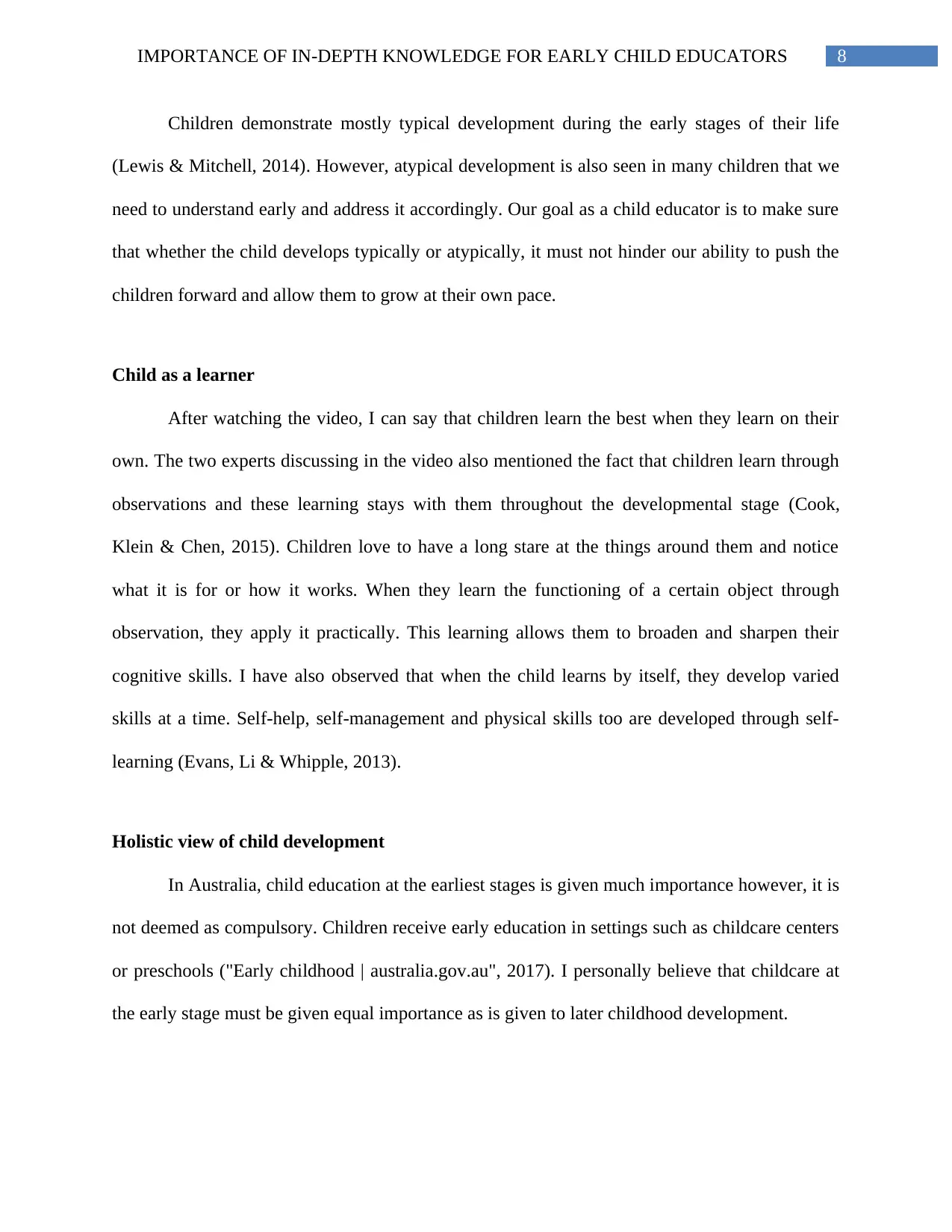
8IMPORTANCE OF IN-DEPTH KNOWLEDGE FOR EARLY CHILD EDUCATORS
Children demonstrate mostly typical development during the early stages of their life
(Lewis & Mitchell, 2014). However, atypical development is also seen in many children that we
need to understand early and address it accordingly. Our goal as a child educator is to make sure
that whether the child develops typically or atypically, it must not hinder our ability to push the
children forward and allow them to grow at their own pace.
Child as a learner
After watching the video, I can say that children learn the best when they learn on their
own. The two experts discussing in the video also mentioned the fact that children learn through
observations and these learning stays with them throughout the developmental stage (Cook,
Klein & Chen, 2015). Children love to have a long stare at the things around them and notice
what it is for or how it works. When they learn the functioning of a certain object through
observation, they apply it practically. This learning allows them to broaden and sharpen their
cognitive skills. I have also observed that when the child learns by itself, they develop varied
skills at a time. Self-help, self-management and physical skills too are developed through self-
learning (Evans, Li & Whipple, 2013).
Holistic view of child development
In Australia, child education at the earliest stages is given much importance however, it is
not deemed as compulsory. Children receive early education in settings such as childcare centers
or preschools ("Early childhood | australia.gov.au", 2017). I personally believe that childcare at
the early stage must be given equal importance as is given to later childhood development.
Children demonstrate mostly typical development during the early stages of their life
(Lewis & Mitchell, 2014). However, atypical development is also seen in many children that we
need to understand early and address it accordingly. Our goal as a child educator is to make sure
that whether the child develops typically or atypically, it must not hinder our ability to push the
children forward and allow them to grow at their own pace.
Child as a learner
After watching the video, I can say that children learn the best when they learn on their
own. The two experts discussing in the video also mentioned the fact that children learn through
observations and these learning stays with them throughout the developmental stage (Cook,
Klein & Chen, 2015). Children love to have a long stare at the things around them and notice
what it is for or how it works. When they learn the functioning of a certain object through
observation, they apply it practically. This learning allows them to broaden and sharpen their
cognitive skills. I have also observed that when the child learns by itself, they develop varied
skills at a time. Self-help, self-management and physical skills too are developed through self-
learning (Evans, Li & Whipple, 2013).
Holistic view of child development
In Australia, child education at the earliest stages is given much importance however, it is
not deemed as compulsory. Children receive early education in settings such as childcare centers
or preschools ("Early childhood | australia.gov.au", 2017). I personally believe that childcare at
the early stage must be given equal importance as is given to later childhood development.
⊘ This is a preview!⊘
Do you want full access?
Subscribe today to unlock all pages.

Trusted by 1+ million students worldwide
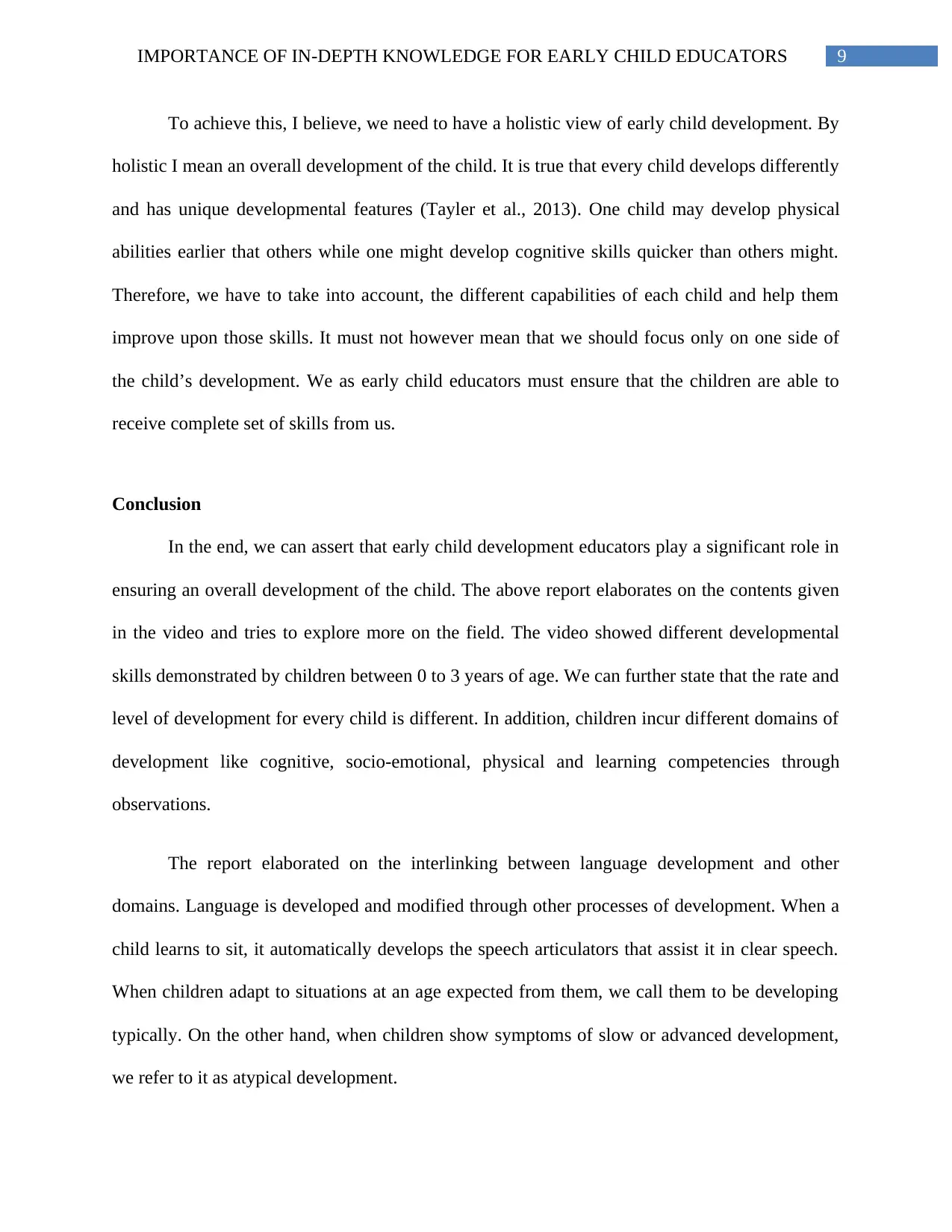
9IMPORTANCE OF IN-DEPTH KNOWLEDGE FOR EARLY CHILD EDUCATORS
To achieve this, I believe, we need to have a holistic view of early child development. By
holistic I mean an overall development of the child. It is true that every child develops differently
and has unique developmental features (Tayler et al., 2013). One child may develop physical
abilities earlier that others while one might develop cognitive skills quicker than others might.
Therefore, we have to take into account, the different capabilities of each child and help them
improve upon those skills. It must not however mean that we should focus only on one side of
the child’s development. We as early child educators must ensure that the children are able to
receive complete set of skills from us.
Conclusion
In the end, we can assert that early child development educators play a significant role in
ensuring an overall development of the child. The above report elaborates on the contents given
in the video and tries to explore more on the field. The video showed different developmental
skills demonstrated by children between 0 to 3 years of age. We can further state that the rate and
level of development for every child is different. In addition, children incur different domains of
development like cognitive, socio-emotional, physical and learning competencies through
observations.
The report elaborated on the interlinking between language development and other
domains. Language is developed and modified through other processes of development. When a
child learns to sit, it automatically develops the speech articulators that assist it in clear speech.
When children adapt to situations at an age expected from them, we call them to be developing
typically. On the other hand, when children show symptoms of slow or advanced development,
we refer to it as atypical development.
To achieve this, I believe, we need to have a holistic view of early child development. By
holistic I mean an overall development of the child. It is true that every child develops differently
and has unique developmental features (Tayler et al., 2013). One child may develop physical
abilities earlier that others while one might develop cognitive skills quicker than others might.
Therefore, we have to take into account, the different capabilities of each child and help them
improve upon those skills. It must not however mean that we should focus only on one side of
the child’s development. We as early child educators must ensure that the children are able to
receive complete set of skills from us.
Conclusion
In the end, we can assert that early child development educators play a significant role in
ensuring an overall development of the child. The above report elaborates on the contents given
in the video and tries to explore more on the field. The video showed different developmental
skills demonstrated by children between 0 to 3 years of age. We can further state that the rate and
level of development for every child is different. In addition, children incur different domains of
development like cognitive, socio-emotional, physical and learning competencies through
observations.
The report elaborated on the interlinking between language development and other
domains. Language is developed and modified through other processes of development. When a
child learns to sit, it automatically develops the speech articulators that assist it in clear speech.
When children adapt to situations at an age expected from them, we call them to be developing
typically. On the other hand, when children show symptoms of slow or advanced development,
we refer to it as atypical development.
Paraphrase This Document
Need a fresh take? Get an instant paraphrase of this document with our AI Paraphraser
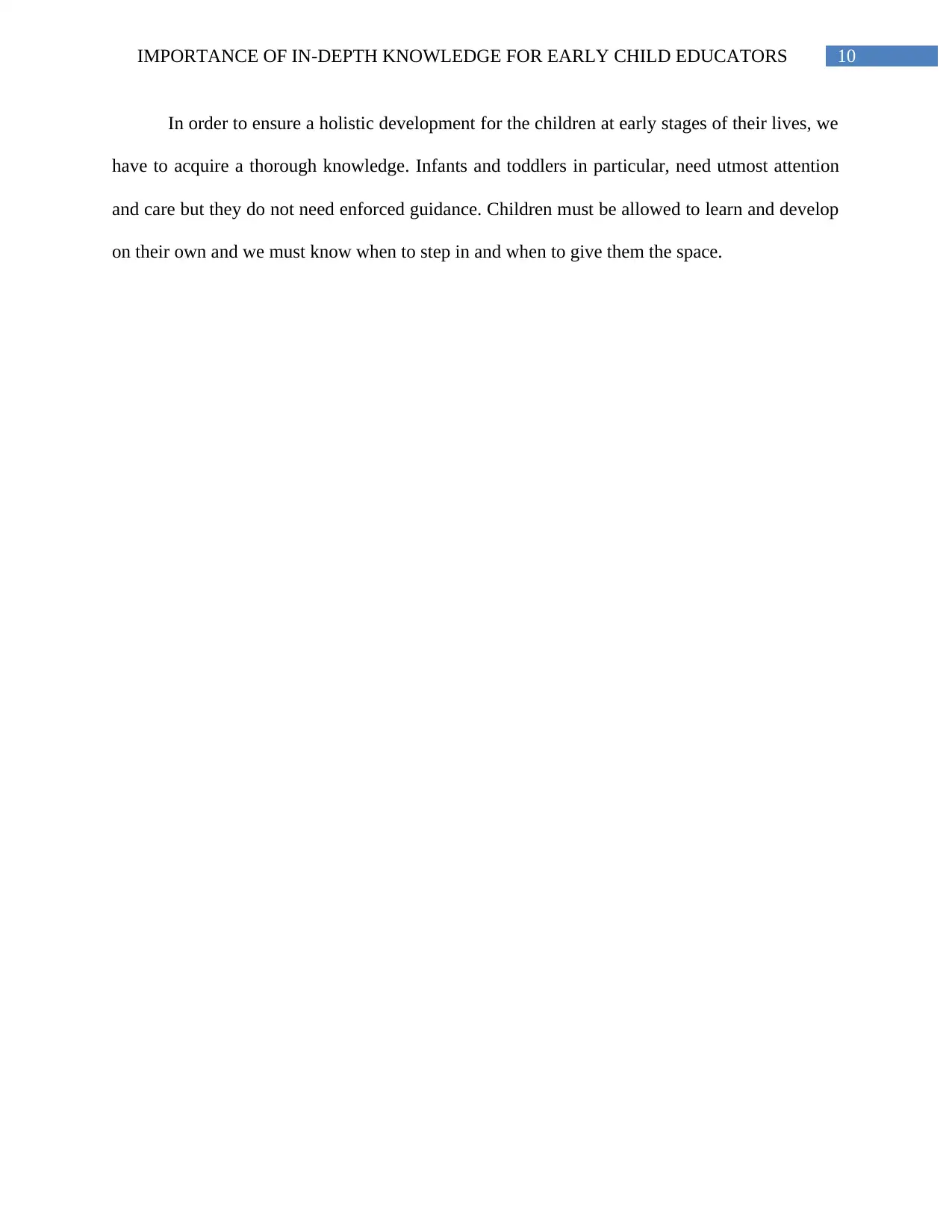
10IMPORTANCE OF IN-DEPTH KNOWLEDGE FOR EARLY CHILD EDUCATORS
In order to ensure a holistic development for the children at early stages of their lives, we
have to acquire a thorough knowledge. Infants and toddlers in particular, need utmost attention
and care but they do not need enforced guidance. Children must be allowed to learn and develop
on their own and we must know when to step in and when to give them the space.
In order to ensure a holistic development for the children at early stages of their lives, we
have to acquire a thorough knowledge. Infants and toddlers in particular, need utmost attention
and care but they do not need enforced guidance. Children must be allowed to learn and develop
on their own and we must know when to step in and when to give them the space.
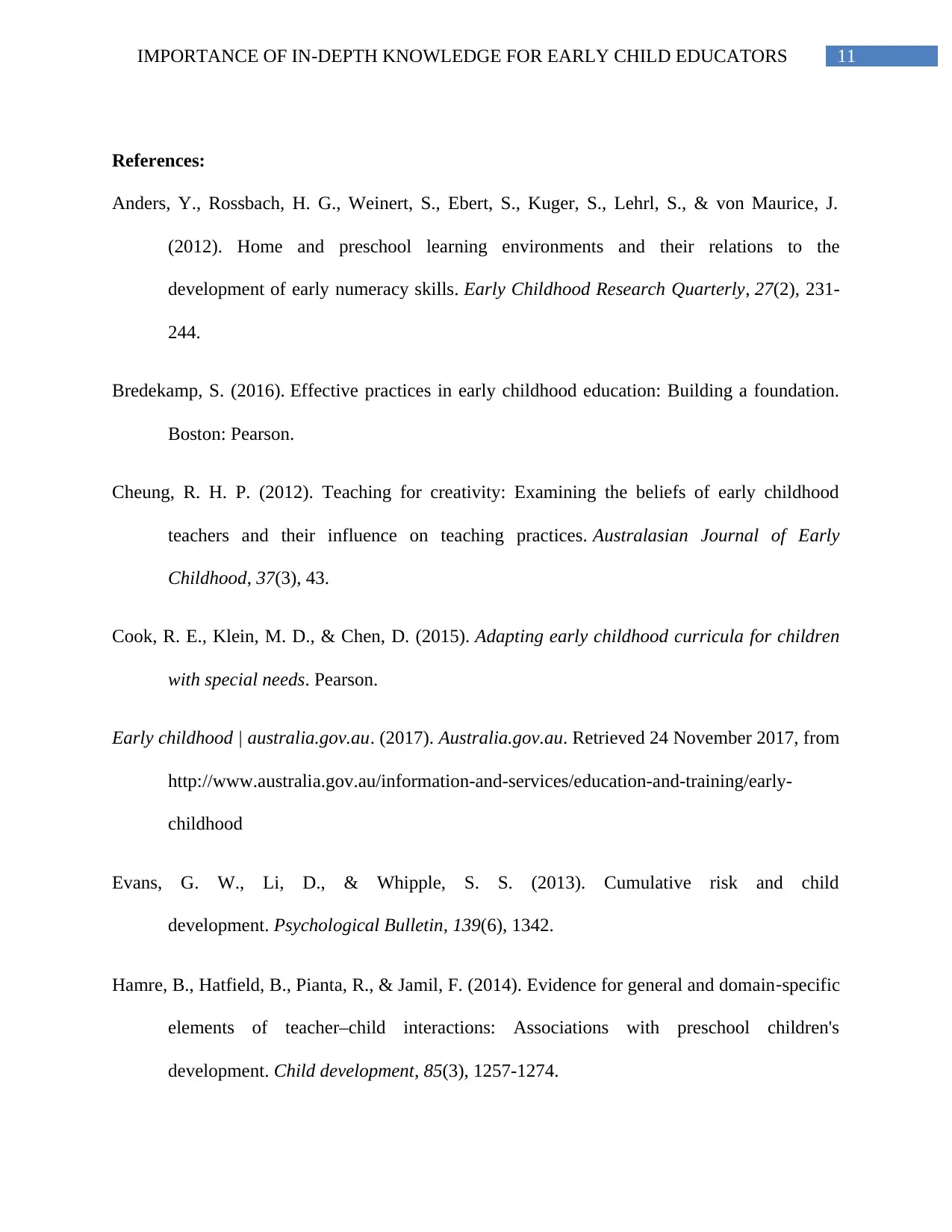
11IMPORTANCE OF IN-DEPTH KNOWLEDGE FOR EARLY CHILD EDUCATORS
References:
Anders, Y., Rossbach, H. G., Weinert, S., Ebert, S., Kuger, S., Lehrl, S., & von Maurice, J.
(2012). Home and preschool learning environments and their relations to the
development of early numeracy skills. Early Childhood Research Quarterly, 27(2), 231-
244.
Bredekamp, S. (2016). Effective practices in early childhood education: Building a foundation.
Boston: Pearson.
Cheung, R. H. P. (2012). Teaching for creativity: Examining the beliefs of early childhood
teachers and their influence on teaching practices. Australasian Journal of Early
Childhood, 37(3), 43.
Cook, R. E., Klein, M. D., & Chen, D. (2015). Adapting early childhood curricula for children
with special needs. Pearson.
Early childhood | australia.gov.au. (2017). Australia.gov.au. Retrieved 24 November 2017, from
http://www.australia.gov.au/information-and-services/education-and-training/early-
childhood
Evans, G. W., Li, D., & Whipple, S. S. (2013). Cumulative risk and child
development. Psychological Bulletin, 139(6), 1342.
Hamre, B., Hatfield, B., Pianta, R., & Jamil, F. (2014). Evidence for general and domain‐specific
elements of teacher–child interactions: Associations with preschool children's
development. Child development, 85(3), 1257-1274.
References:
Anders, Y., Rossbach, H. G., Weinert, S., Ebert, S., Kuger, S., Lehrl, S., & von Maurice, J.
(2012). Home and preschool learning environments and their relations to the
development of early numeracy skills. Early Childhood Research Quarterly, 27(2), 231-
244.
Bredekamp, S. (2016). Effective practices in early childhood education: Building a foundation.
Boston: Pearson.
Cheung, R. H. P. (2012). Teaching for creativity: Examining the beliefs of early childhood
teachers and their influence on teaching practices. Australasian Journal of Early
Childhood, 37(3), 43.
Cook, R. E., Klein, M. D., & Chen, D. (2015). Adapting early childhood curricula for children
with special needs. Pearson.
Early childhood | australia.gov.au. (2017). Australia.gov.au. Retrieved 24 November 2017, from
http://www.australia.gov.au/information-and-services/education-and-training/early-
childhood
Evans, G. W., Li, D., & Whipple, S. S. (2013). Cumulative risk and child
development. Psychological Bulletin, 139(6), 1342.
Hamre, B., Hatfield, B., Pianta, R., & Jamil, F. (2014). Evidence for general and domain‐specific
elements of teacher–child interactions: Associations with preschool children's
development. Child development, 85(3), 1257-1274.
⊘ This is a preview!⊘
Do you want full access?
Subscribe today to unlock all pages.

Trusted by 1+ million students worldwide
1 out of 13
Related Documents
Your All-in-One AI-Powered Toolkit for Academic Success.
+13062052269
info@desklib.com
Available 24*7 on WhatsApp / Email
![[object Object]](/_next/static/media/star-bottom.7253800d.svg)
Unlock your academic potential
Copyright © 2020–2025 A2Z Services. All Rights Reserved. Developed and managed by ZUCOL.





